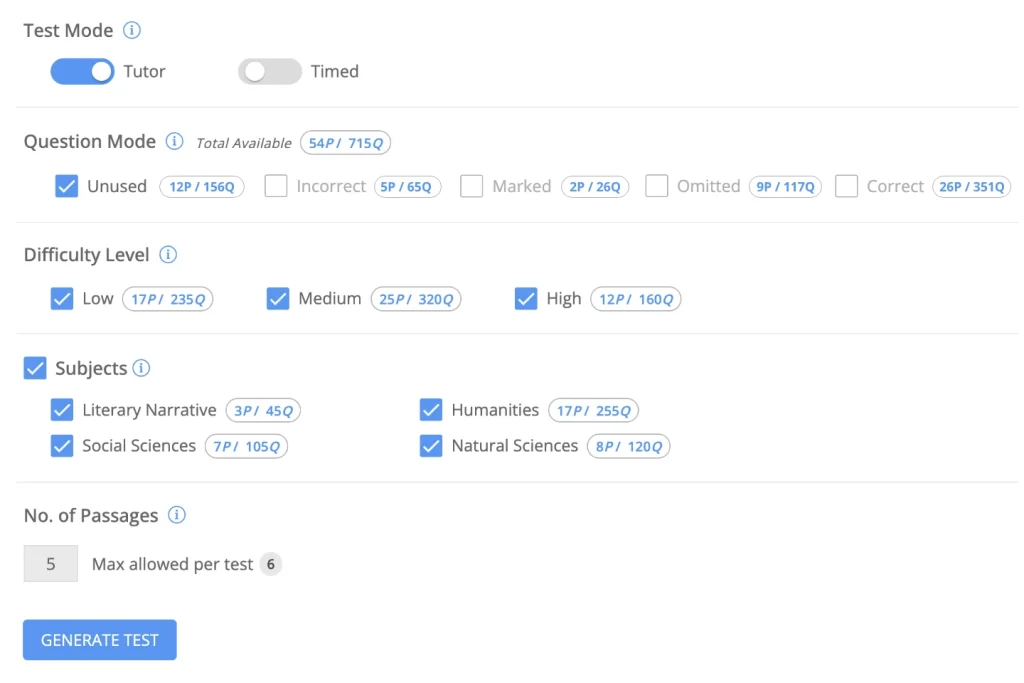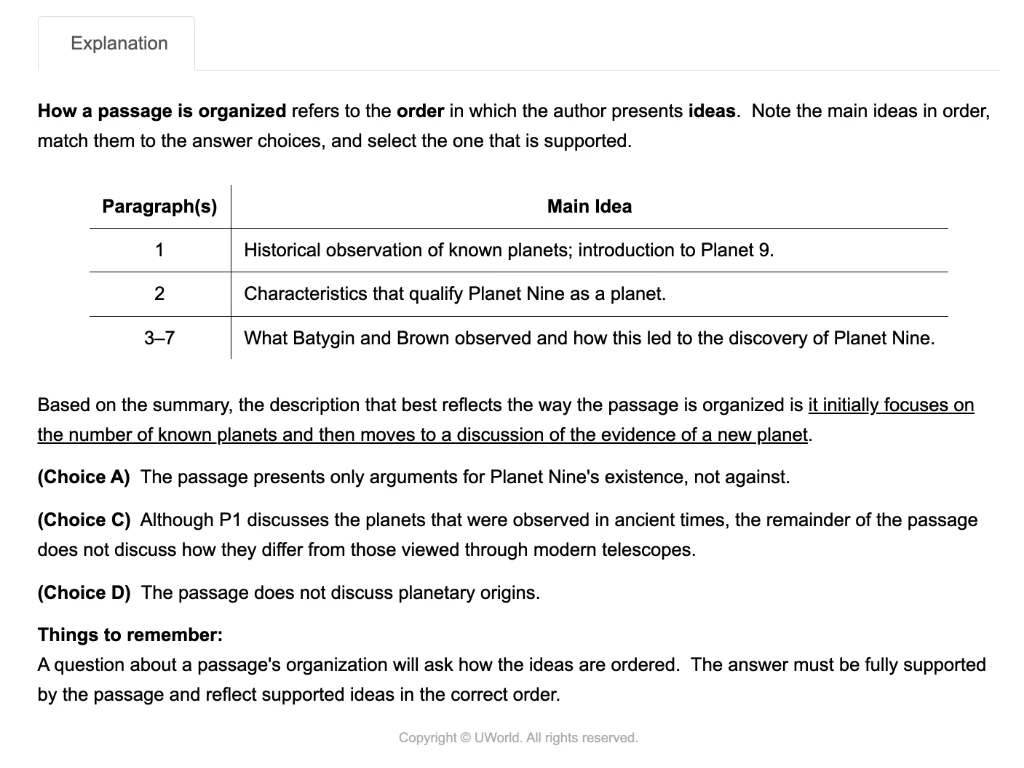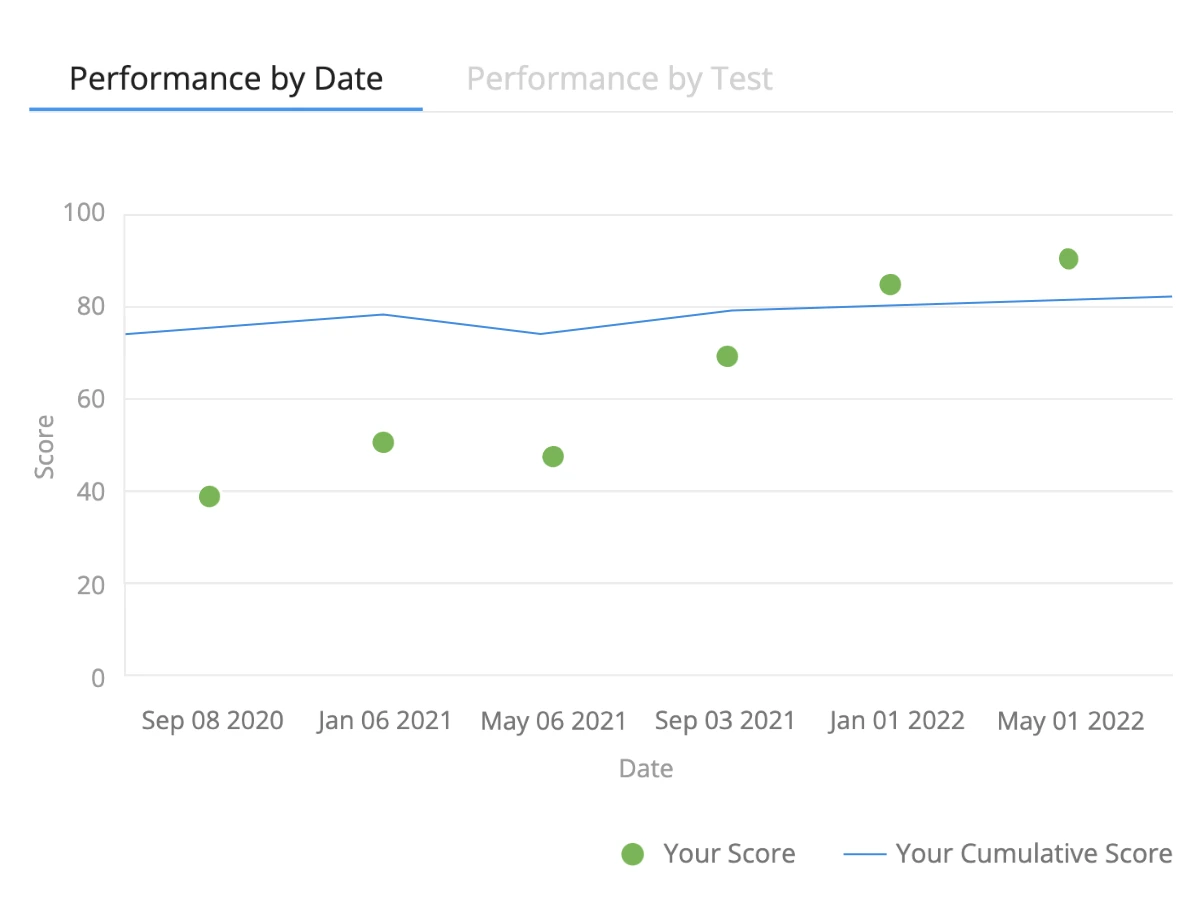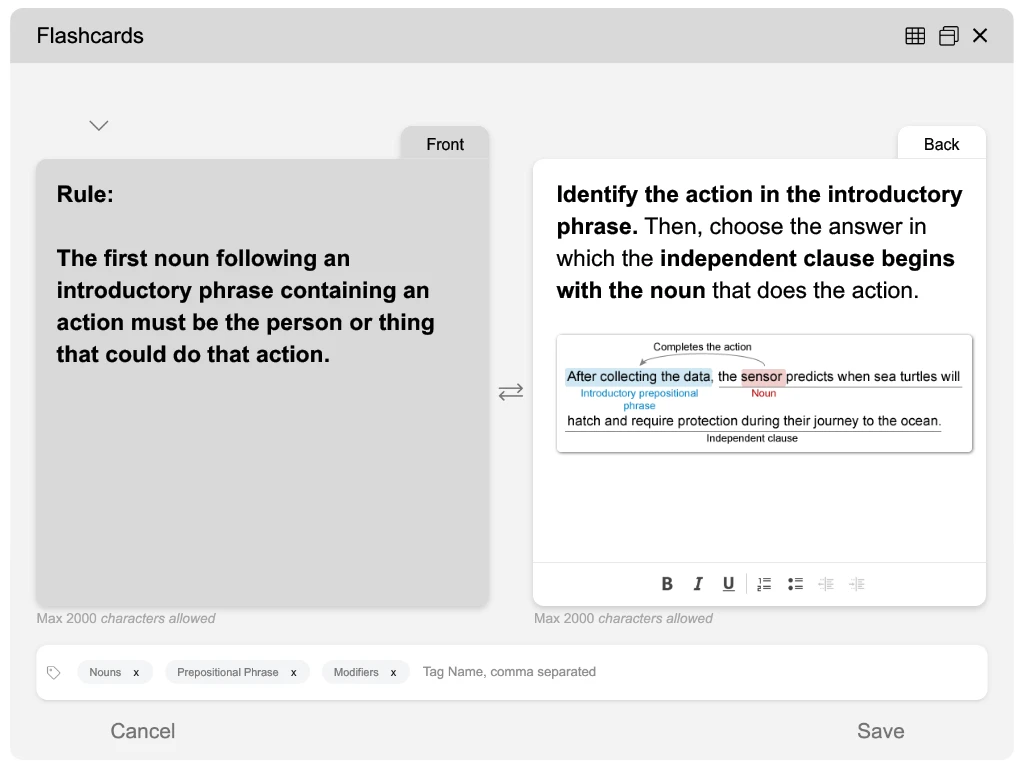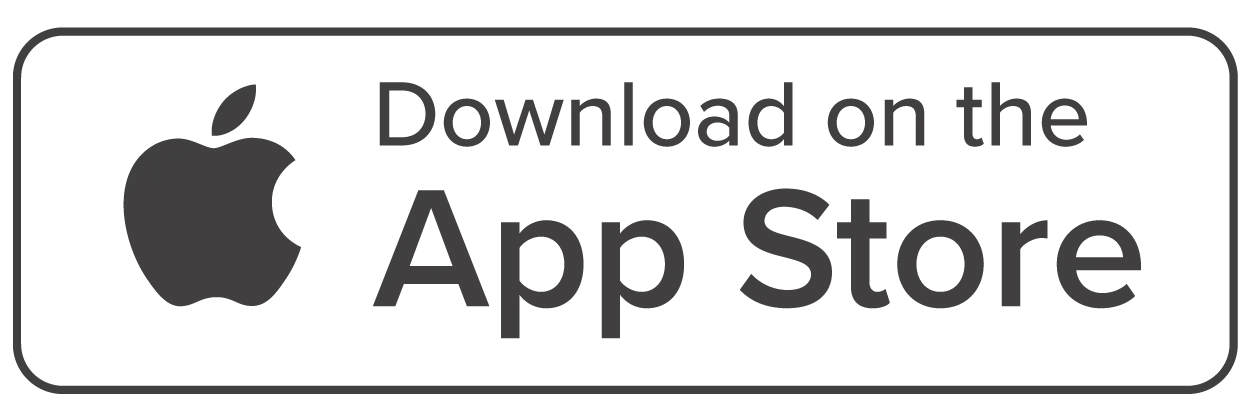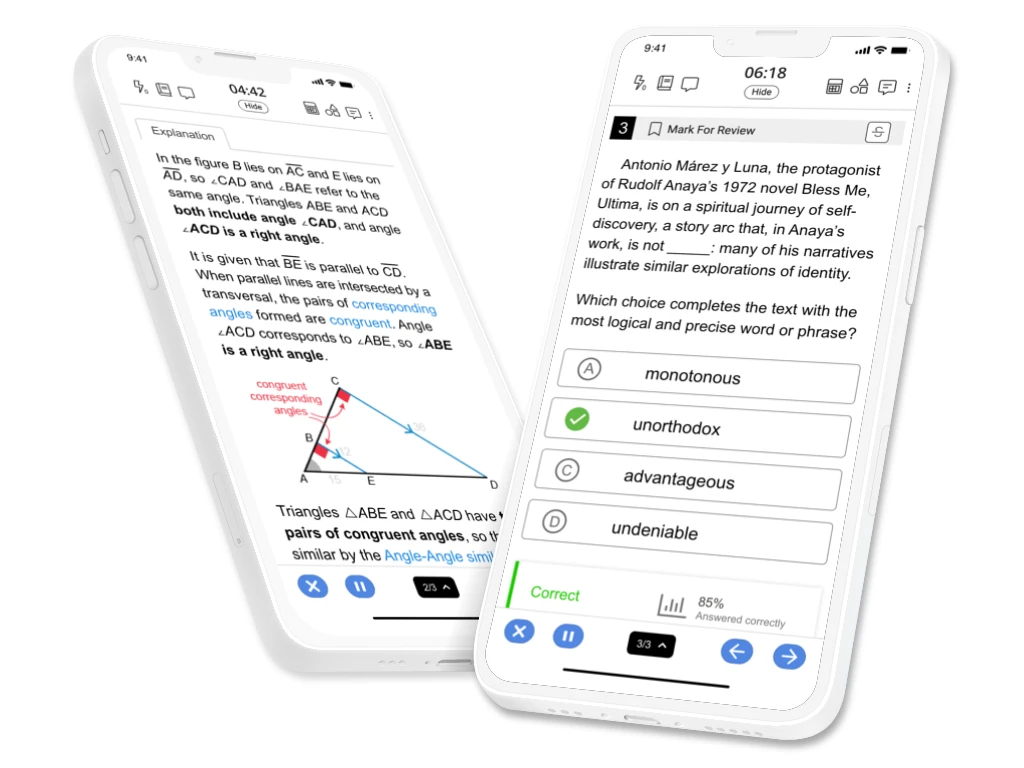ACT® English Practice Tests and Questions
Our ACT® English Practice Tests and Questions are written by subject matter experts to meet or exceed exam-level difficulty, because we believe that if practice feels like the actual exam, the real thing will feel like practice. Not getting something? We’ve got you covered with in-depth answer explanations and vivid illustrations that make hard stuff easy to understand.
Get Exam-Ready with Exam-Like ACT English Practice
Unlimited Exam-level Practice
Customized to Your Needs
Understand the Why
ACT English Sample Questions
When people think of national parks, they’re probably more likely to envision densely forested peeks than sparse deserts. And even though a desert plant is not as impressive a park feature as the Grand Canyon or Petrified Forest, Joshua Tree National Park boasts parts of two deserts: the higher Mojave and the lower Colorado. It’s an extensive park, slightly larger than Rhode Island, that was named after a tree-like desert plant species. But this area might never have become what it is today without the involvement of a woman who tirelessly worked, promoted, and eventually succeeded in convincing the government to protect and would become a monument in 1936 and a bona fide national park in 1994.
Civic activist, Minerva Hamilton Hoyt, became interested in plants like cactuses and Joshua trees because of her love for gardening. As a result, Hoyt began to exhibit desert plants across the country to educate people about their qualities. In reality, to expand her audience, Hoyt exhibited to other gardens, some as far away as London. Two years after her first 1928 Garden Club of America show in New York, which was when Hoyt founded the International Desert Conservation League.
Hoyt might have never started her efforts on behalf of Southern California’s desert plants had it not been for her growing concern that increased automobile traffic was threatening those plants in that region of that state. Therefore, in an effort to protect these desert plants, Hoyt crusaded for the creation of Joshua Tree National Park by the state of California throughout the 1930s. She wasn’t afraid to petition local and state officials, among others, to join her park campaign.
She also persuaded the Mexican government to set aside 10,000 acres for cactus preservation. In fact, in 1931, a species of Mexican cactus was named after Hoyt. Then in 2013, a mountaintop within Joshua Tree was named after her. Even today the Joshua Tree National Park Association annually honors “notable achievement on behalf of the deserts of California” with it’s Minerva Hoyt Award, a fitting tribute to the woman who I think deserves to be honored.
Paragraph 3: …in an effort to protect these desert plants, Hoyt crusaded for the creation of Joshua Tree National Park by the state of California throughout the 1930s. She wasn’t afraid to petition local and state officials, among others, to join her park campaign.
P4: She also persuaded the Mexican government to set aside 10,000 acres for cactus preservation. In fact, in 1931, a species of Mexican cactus was named after Hoyt. Then in 2013, a mountaintop within Joshua Tree was named after her.
Given that all the statements are true, which one provides the most effective transition from the preceding paragraph to this paragraph?
- NO CHANGE
- Eventually Hoyt was recognized for her conservation efforts.
- Hoyt’s Joshua Tree promotion left a permanent stamp on American culture.
- Hoyt had the money to promote this cause because she was a wealthy socialite.
Paragraph 3: …in an effort to protect these desert plants, Hoyt crusaded for the creation of Joshua Tree National Park by the state of California throughout the 1930s. She wasn’t afraid to petition local and state officials, among others, to join her park campaign.
P4: Eventually Hoyt was recognized for her conservation efforts. In fact, in 1931, a species of Mexican cactus was named after Hoyt. Then in 2013, a mountaintop within Joshua Tree was named after her.
An effective transition at the beginning of a paragraph will connect ideas from the previous paragraph to ideas in the one with the transition.
P3 discusses Hoyt’s concerns about conserving the desert plants in Southern California and her efforts to get these areas declared a national park. P4 explains how “Hoyt was recognized” for her “conservation efforts” by having desert plants and an award named after her.
(Choice A) Although this sentence would match the rest of the paragraph by introducing the fact that “a species of Mexican cactus was named after Hoyt,” it does not refer back to the previous paragraph in which Hoyt worked to protect desert plants.
(Choice C) Although Hoyt promoted the Joshua tree, the idea that her efforts “left a permanent stamp [impact] on American culture [beliefs of a specific group]” doesn’t connect to the honors she received. Although a cactus and mountaintop are still referred to by her name, that doesn’t mean people know who Hoyt was or what she did.
(Choice D) Hoyt’s money doesn’t necessarily have anything to do with her efforts to preserve desert plants or the honors she received, as discussed in the paragraphs before and after the transition sentence.
Things to remember:
To determine which sentence is the best transition, choose the one that contains ideas connecting the previous paragraph and the current one.
In the 1950s, the La Sal Creek Mineral Belt was mined for its uranium and vanadium, but this enterprise has since been abandoned. In 2000, after conducting detailed water and sediment sampling to determine the level of contaminants, the Bureau of Land Management (BLM) finalized a safety and health plan for this area. Now, the site is monitored very closely, and maintained by government officials, those who ensured that arsenic, other radioactive materials, and anything else that usually could be called like hazardous waste pose no threat to humans or the environment.
The five abandoned La Sal Creek mines contain horizontal passageways, where miners bored through the rock. Lying within each one of these passageways, however, waste materials exist that could pollute really big areas of both surface and groundwater. As a result, this waste had the potential to threaten aquatic life within both La Sal and nearby Lion Canyon Creek.
Highly acidic water rich in metals, or AMD, is a serious problem in many mines with metallic passageways. These mines can produce AMD for more than 100 years, which can lower the pH of surrounding surface water, making it sour and unable to support many forms of aquatic life and vegetation. Humans may also be affected by consuming water and fish tissue with metal content.
Many of the waters and lands affected by the waste from abandoned mines are the homes of threatened or endangered species like bats. Also, in the southwest United States, many desert plant species are dependent on pollination by bats. In many instances, bats are displaced from their preferred roosting sites by encroaching human development. Although mines are human-made, they have become critical in conservation’s effort. Bats play an important ecosystem role by controlling nighttime flying insects. In fact, a single little brown bat can catch 600 mosquitoes in just one hour. Therefore, even though abandoned mines present potential hazards, they also offer possible homes for otherwise displaced animals to live in deserted man-made dwellings.
1. This work, “Securing the La Salle Creek Mines,” is a derivative of “La Sal Creek Watershed” by AbandonedMines.gov, managed by the Bureau of Land Management, and published under public domain.
2. This work, “Securing the La Salle Creek Mines,” is a derivative of “Water Pollution” by AbandonedMines.gov, managed by the Bureau of Land Management, and published under public domain.
3. This work, “Securing the La Salle Creek Mines,” is a derivative of “Threatened & Endangered Species” by AbandonedMines.gov, managed by the Bureau of Land Management, and published under public domain.
Highly acidic water rich in metals, or AMD, is a serious problem in many mines with metallic passageways. These mines can produce AMD for more than 100 years, which can lower the pH of surrounding surface water….
- NO CHANGE
- contaminated water areas.
- places with low pH.
- abandoned mines.
P3: Highly acidic water rich in metals, or AMD, is a serious problem in many abandoned mines. These mines can produce AMD for more than 100 years, which can lower the pH of surrounding surface water….
When you have to choose the best phrase, look for one that clarifies what’s being discussed but doesn’t repeat ideas from that sentence or nearby sentences.
Here, the only phrase that doesn’t repeat ideas is “abandoned mines.” Although “abandoned mines” are mentioned elsewhere in the passage, it is the only choice not mentioned in this or neighboring sentences.
(Choices A, B, & C) All these choices repeat ideas either already in the sentence or in nearby sentences.
- Choice A uses the word “metallic,” which repeats the idea of “metals” already mentioned in the sentence.
- Choice B repeats the word “water” used earlier in the sentence.
- Choice C repeats the idea of “acidic” from earlier in the sentence by using the phrase “low pH,” which is almost the same wording as “lower pH” found in the next sentence.
Things to remember:
The best phrase won’t repeat ideas from the sentence in question or surrounding sentences but will clarify the ideas being discussed.
My grandfather called them mason bees, but people around here call them orchard bees. As I watch them, I think how like the blue orchard bee I am. At certain times of the year, I’m out flitting around, helping others. One of these bees pollinate fruit trees just like I encourage new growth—only I work with students.
Setting up my classroom, it is similar to the way they build their nests. These bees use clay to make partitions to seal the entrance to the hive. My partition is the door to my classroom, and I wonder whether it is better at keeping people out or trapping students inside. However, my educational efforts, unlike the blue orchard bee prized for its efficiency pollinating fruit trees, are not valued in the same way for creating stimulation for the minds of children. Similar to how mason bees sometimes isolate themselves from others, I sometimes am seen myself as a solitary creature, tending to my own brood. On the other hand, we also both like the company of others of our kind and has taken time to build our nests next to each other.
When I go home to my garden, I wonder if I can encourage the bees to visit by placing store-bought bee houses in my yard. Some other incentive would probably be needed, therefore, to get them to come. I know I feel that way about staff meetings when the administrators give us donuts and muffins, as well as juice to encourage us to keep showing up as they drone on and on, sharing the latest buzz about the best way to get students to learn.
It is early spring, and now is prime season for the blue orchard bee. My season runs the course of the school year and will come to an end soon. Before laying there eggs, these bees seal the entrance to protect the larvae. But when the bell rings, I let my students go. Like the larvae that grow and change, maturing young students into adults. My season runs the course of the school year and will come to an end soon. Hopefully this group placed in my care will emerge after our time together to find their bloom and pollinate others. I wish I could do the same and protect these youngsters from everything that discourages them from learning.
At certain times of the year, I’m out flitting around, helping others. One of these bees pollinate fruit trees just like I encourage new growth—only I work with students.
- NO CHANGE
- Many
- Each
- Any one
At certain times of the year, I’m out flitting around, helping others. Many of these bees pollinate fruit trees just like I encourage new growth—only I work with students.
Subjects should agree in number—singular (one) or plural (more than one)—with the verbs they describe in the sentence.
| Singular | Plural |
|---|---|
| One bee pollinates | Many bees pollinate |
Notice how regular singular verbs end with an “s” whereas regular plural verbs don’t.
Because the verb in the sentence is the plural “pollinate,” a plural subject is required. The only plural answer choice is “many,” making it the correct answer.
Tip: Formally, as on this test, “each” is always singular—think “each one”—and can’t pair with a plural verb. (Incorrect: Each of them are happy. Correct: Each of them is happy.)
(Choices A, C, & D) These answers are all singular pronouns that would not agree with the plural verb “pollinate.” Remember that prepositional phrases like “of these bees” cannot contain the subject of a sentence, so ignore them when you’re matching subjects and verbs.
- Choice A: “One…pollinate.”
- Choice C: “Each [one]…pollinate.”
- Choice D: “Any one…pollinate.”
Things to remember:
A pronoun can be used as a subject, but it has to agree in number (singular or plural) with the verb that describes it.
Because the New York City Subway was originally built by three separate companies, an official map for these areas encroaching below was not created until 1940, when they were consolidated under a single operator. To be specific, earlier maps only showed the route of the company that owned it, so passengers who wanted to go on a line owned by a different company needed a separate map. The first route maps were aesthetically pleasing, but they were perceived as being more inscrutable than the existing diagrams.
After the Board of Transportation took over the subway-operating companies in July 1940, separate maps continued to be issued until 1942. Focusing on providing a simpler way to help travelers who needed to navigate the subway system, the Board used externally produced, integrated maps. More a way to convey Board service information beyond a helpful map; it was all a traveler could get at the token booths. Then in 1953, the New York City Transit Authority (NYCTA) took over the subway from the Board of Transportation and looked for ways to save money on the map. In 1955, George Salomon submitted a proposal to redesign the map based on a system of route names using also color schemes that mirrored Berlin’s U-Bahn. His map also adopted the same modernist style as Harry Beck’s London map. Even though the NYCTA rejected his naming system, Salomon created a map that ultimately gained acceptance and became the official one used by the NYCTA from 1958 to 1967.
To reform bottlenecks in the subway system, a series of major works were carried out in the 1960s. Realizing the need for a new mapping system, a citywide Subway Map Competition was held by the Transit Authority that was opened to the general public. R. Raleigh D’Adamo, one of the three winners, submitted an innovative proposal to color-code the subway by individual routes rather than by historic operating company. When the new connections opened in 1967, the new map began being used. One of these was adding new lines that unified two older divisions of the subway and made the three-colored network maps obsolete.
New York City’s unique approach to mapping, was an anomaly in that it showed city streets, parks, and neighborhoods juxtaposed among these, whereas other worldwide subway maps with straight lines did not show such aboveground features. The color-coded map was not well received and was ultimately redesigned after the NYCTA became the Metropolitan Transportation Authority (MTA). Extensive changes to this map were made six times from 1973–1978. The most recent official map is not geographically accurate but does help tourists navigate the city, as it’s major streets are shown alongside the subway stations serving them.
More a way to convey Board service information beyond a helpful map; it was all a traveler could get at the token booths.
- NO CHANGE
- than
- rather
- for
More a way to convey Board service information than a helpful map; it was all a traveler could get at the token booths.
Prepositions often pair with other words, so look at the sentence for context clues that might indicate which answer choice is correct.
The first word in this sentence is “more,” which often pairs with the preposition “than” to show that one thing has more importance than another.
In this case, the sentence emphasizes that the map put more emphasis on “convey[ing] [showing] Board service information” than it did on giving people direction.
(Choice A) When used as a preposition, “beyond” can mean “in addition to” or “besides.” However, this preposition would indicate that the map was helpful, while the rest of the sentence implies that it wasn’t very helpful to travelers.
(Choice C) “Rather” is usually used as an adverb and means “to the contrary” or “instead.” (Ex. More of a distraction rather than a calming influence, the music needed to be turned off.) For “rather” to work as a preposition in this sentence, it would have to be paired with “than.”
(Choice D) “For” often indicates the object (purpose) of an activity. (Ex. The event was held to raise money for charity.) However, the object of the map shouldn’t have been to convey “Board Service information” but rather to help travelers find their way.
Things to remember:
The correct preposition will have a meaning that works in context and will often be paired with another word in the sentence, so use context clues to help determine the right answer.
Impeachment, which exists under constitutional law in many countries beyond the world, is the process by which a legislative body levels charges against a government official. Impeachment does not, in itself, remove the official definitively of office. It is similar to an indictment in criminal law, it is essentially the statement of charges against the official. Whereas in some countries the individual is provisionally removed, in others the official can remain in office during the trial. Once someone is impeached, that individual must then face the possibility of conviction on the charges by a legislative vote. This vote is separate from the impeachment process yet this vote flows from it. Any subsequent judgment that convicts the official on the articles of impeachment entails the official’s definitive removal from office.
Impeachment of officials involves an overturning of the normal constitutional procedures by which individuals achieve high office (election, ratification, or appointment) and generally requires a supermajority, so this process is usually reserved for those deemed to have committed serious abuses of their office. In the United States, for example, impeachment between the federal level is limited to those who have committed “treason, bribery, or other high crimes and misdemeanors.”
Outside of ancient Greek and Roman political systems, impeachment was first used in England by the “Good Parliament” against Baron Latimer in the second half of the 14th century. Following the British example, the constitutions of Virginia (1776), Massachusetts (1780), and other states adopted the impeachment mechanism, but they restricted the punishment to removal of the official from office.
Article One of the United States Constitution gives the House of Representatives the sole power of impeachment allowing also the Senate the sole power to try impeachments of officers of the U.S. federal government. An official who is impeached faces a second legislative vote (whether by the same body or another), which determines conviction on the charges embodied by the impeachment. Since the subject of the charge is criminal action, this Senate hearing does not constitute a criminal trial. The only questions under consideration are the removal of the individual from office and the possibility of a subsequent vote preventing the removed official from ever again holding political office in the jurisdiction where he or she was removed.
Since the subject of the charge is criminal action, this Senate hearing does not constitute a criminal trial.
- NO CHANGE
- After
- Although
- For
The first word in a dependent clause that begins a sentence should have a meaning that logically connects to the independent clause.
“Although” indicates a contrast. (Ex. Although I’m hungry, I’m not going to eat.) Because it logically contrasts the dependent clause’s idea that the charge is criminal with the independent clause’s point about the Senate hearing not being the same thing as a criminal trial, although is correct.
(Choice A) “Since” = in view of the fact that. This word sets up a cause-and-effect relationship. (Ex. Since I’m going to Washington D.C., I will visit the Smithsonian Museum.) However, the Senate hearing not being a criminal trial isn’t the result of the charge being a criminal action.
(Choice B) “After” = following in time. (Ex. After you go, I will be sad.) However, this sentence doesn’t indicate a time order, and it wouldn’t make sense to say that “after the subject of the charge is criminal action,” the Senate hearing is not a criminal trial.
(Choice D) “For” = indicates a purpose or a goal. (Ex. For every point they scored, their opponent scored two.) However, the sentence indicates that just because a criminal action has been charged doesn’t mean that the Senate’s hearing is a criminal one. Therefore, one is not the goal of the other. Things to remember: Look at the relationship between the information in the dependent and independent clauses to help you determine the best word to begin the sentence.
Score Free ACT Questions Every Week!
Get ACT exam-ready with weekly exam-like questions sent to your inbox.
Aim for a 36 on ACT English Section with UWorld
Study content crafted by subject matter experts, assess yourself with exam-level practice, measure your performance, target your weaknesses with focused study, and repeat.
UWorld's question bank can be described in one word: revolutionary. It accurately models the content that you would see on the test and familiarizes you with the test through PRACTICE, not mindless reading of the content. After using UWorld's amazing question bank, I was able to score a 36. It's proven to work and yielded amazingly good results for me!”
- Ravi
Create Unlimited Practice Tests with Exam-Level Questions
- What if you could take the ACT English as many times as you needed before it actually counted? Well, you can.
- Create as many practice tests as you need using hundreds of exam-level questions.
- Customize by topic, custom tag, or even just questions you’ve previously gotten wrong.
Create Unlimited Practice Tests with Exam-Level Questions
- What if you could take the ACT English as many times as you needed before it actually counted? Well, you can.
- Create as many practice tests as you need using hundreds of exam-level questions.
- Customize by topic, custom tag, or even just questions you’ve previously gotten wrong.
Understand Why an Answer is Right or Wrong
- Dive right into detailed explanations and helpful illustrations to gain a clear understanding in no time.
- Highlight and click to save important source content to our customizable digital flashcards, then review anytime. Using these you’ll master ACT English boost your recall and retention quickly.
Understand Why an Answer is Right or Wrong
- Dive right into detailed explanations and helpful illustrations to gain a clear understanding in no time.
- Highlight and click to save important source content to our customizable digital flashcards, then review anytime. Using these you’ll master ACT English boost your recall and retention quickly.
Track Your Progress With Advanced Analytics
- Unlocking your true potential means acknowledging your areas for growth. With our advanced analytics, you'll receive instant feedback on every practice test, empowering you to track your progress and transform weaknesses into strengths. Our score predictors will guide you along the way.
- You can even compare your results to your peers. Once you know where you’re lacking, you’ll know exactly what you need to study.
Track Your Progress With Advanced Analytics
- Unlocking your true potential means acknowledging your areas for growth. With our advanced analytics, you'll receive instant feedback on every practice test, empowering you to track your progress and transform weaknesses into strengths. Our score predictors will guide you along the way.
- You can even compare your results to your peers. Once you know where you’re lacking, you’ll know exactly what you need to study.
Features: My Notebook & Flashcards
- Simply click, highlight, and select to effortlessly transfer visual and written content from QBank to your digital My Notebook and Flashcards. It's that simple!
- Tailor these tools to your growth areas and keep them all organized by topic or custom tag.
- The best part? These resources are always in arms reach with our mobile app.
Features: My Notebook & Flashcards
- Simply click, highlight, and select to effortlessly transfer visual and written content from QBank to your digital My Notebook and Flashcards. It's that simple!
- Tailor these tools to your growth areas and keep them all organized by topic or custom tag.
- The best part? These resources are always in arms reach with our mobile app.
We make the real thing feel like practice
We believe that if practice feels like the actual exam, then the actual exam will feel like practice. UWorld simulates the actual ACT, so you’ll have all the confidence you need come exam day.
Practice ACT English Sample Questions Anywhere at Any Time
Great ACT English Scores make Students Happy
The primary reason for me being extremely likely to recommend UWorld to a friend is because it has helped me prepare and achieve a 35 Composite ACT Score!
The UWorld question bank has allowed me to make great improvements to each of the subjects on the ACT. The question bank is easy to use and the tutoring mode has helped me to make leaps in my test taking ability.
Before I switched to UWorld, studying for the ACT was extremely frustrating! The countless strategy books in my closet were too overwhelming to begin studying. When I found UWorld, preparing for the exam became quick and easy. I could take mock tests to see my strengths and weaknesses in certain subjects, and learning became fun! I received a better ACT score than I could have imagined!
